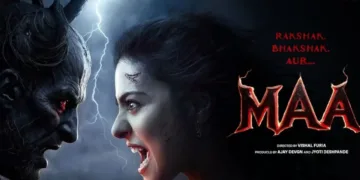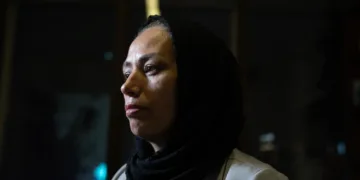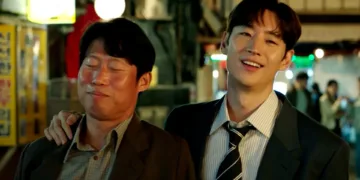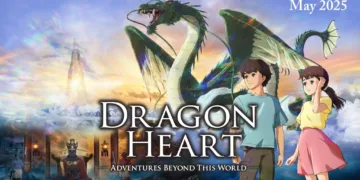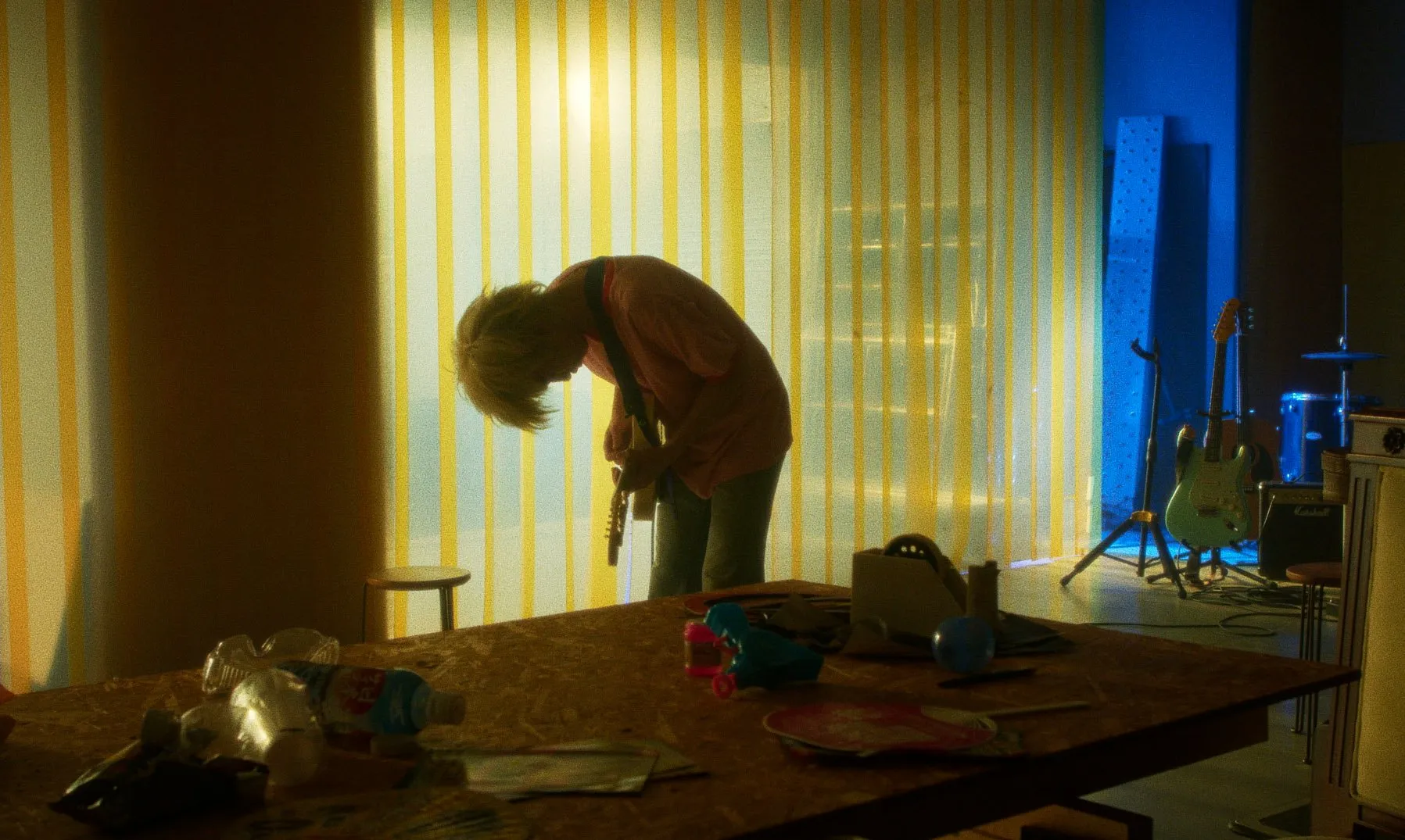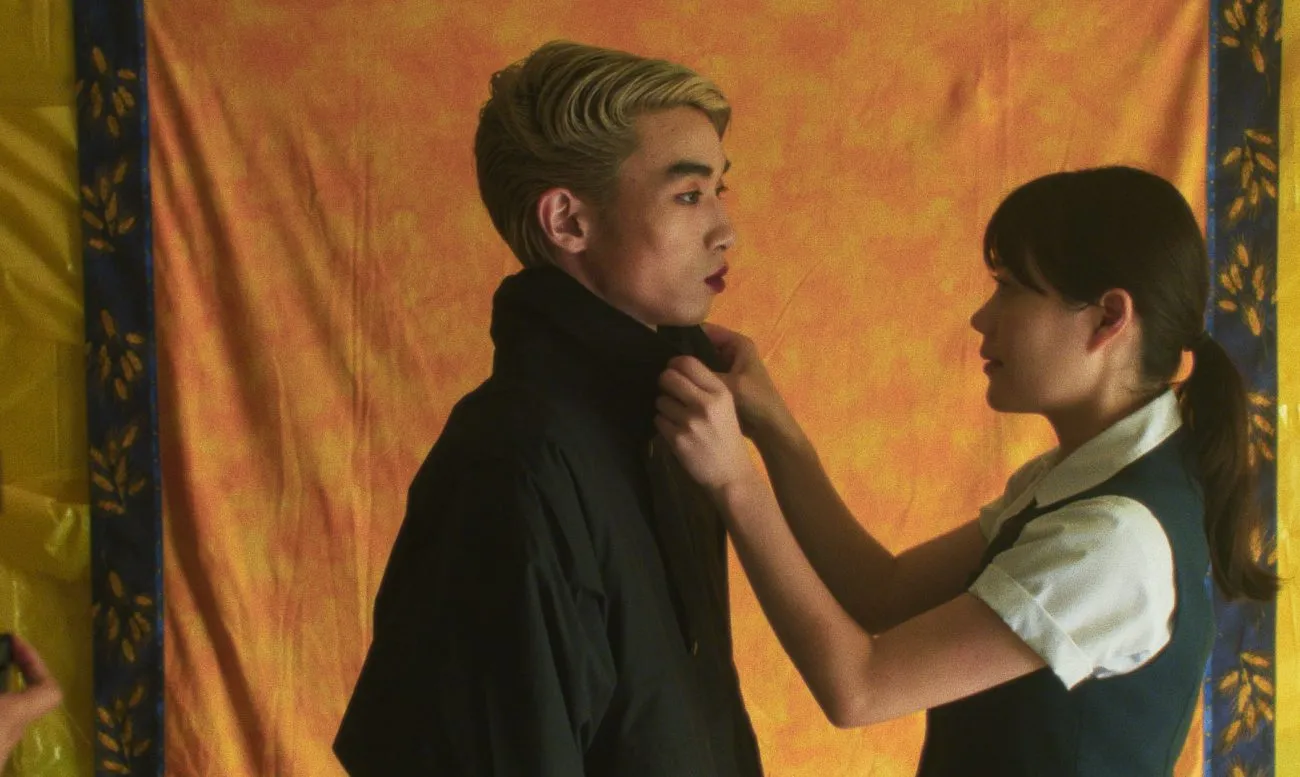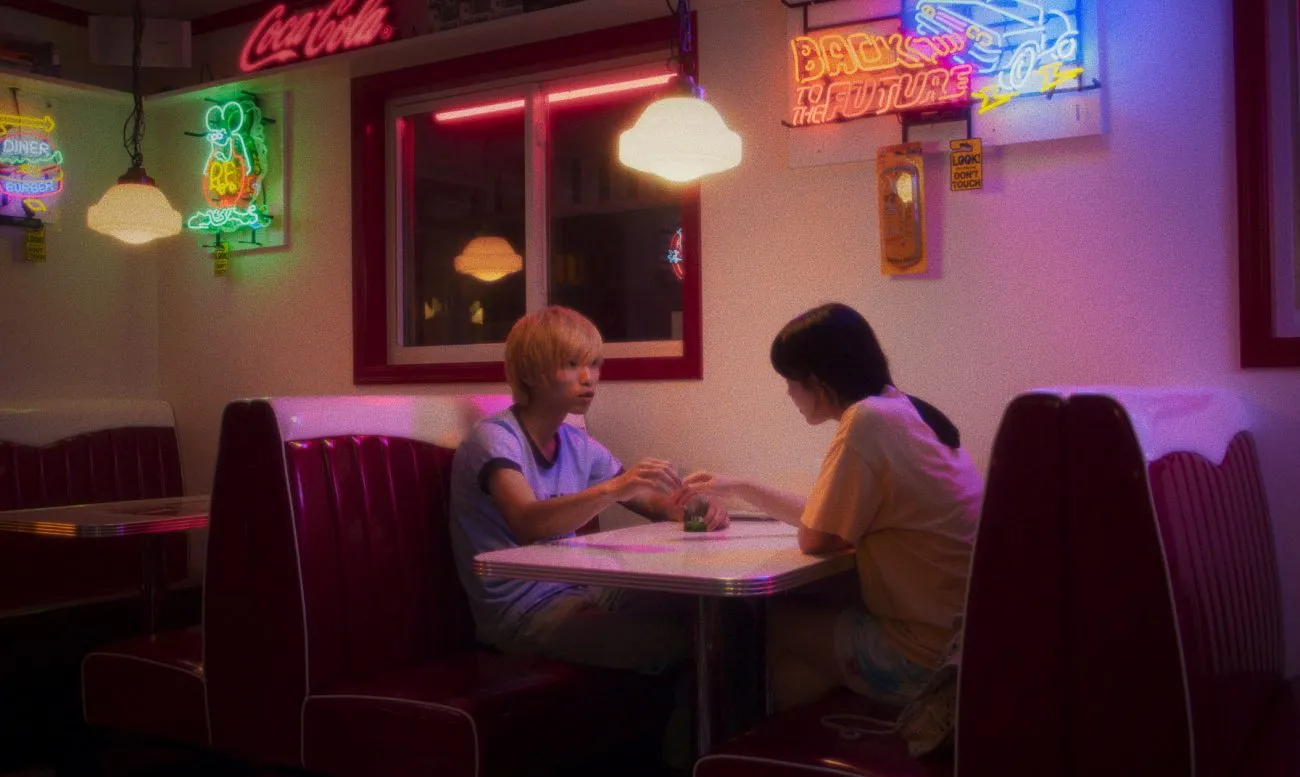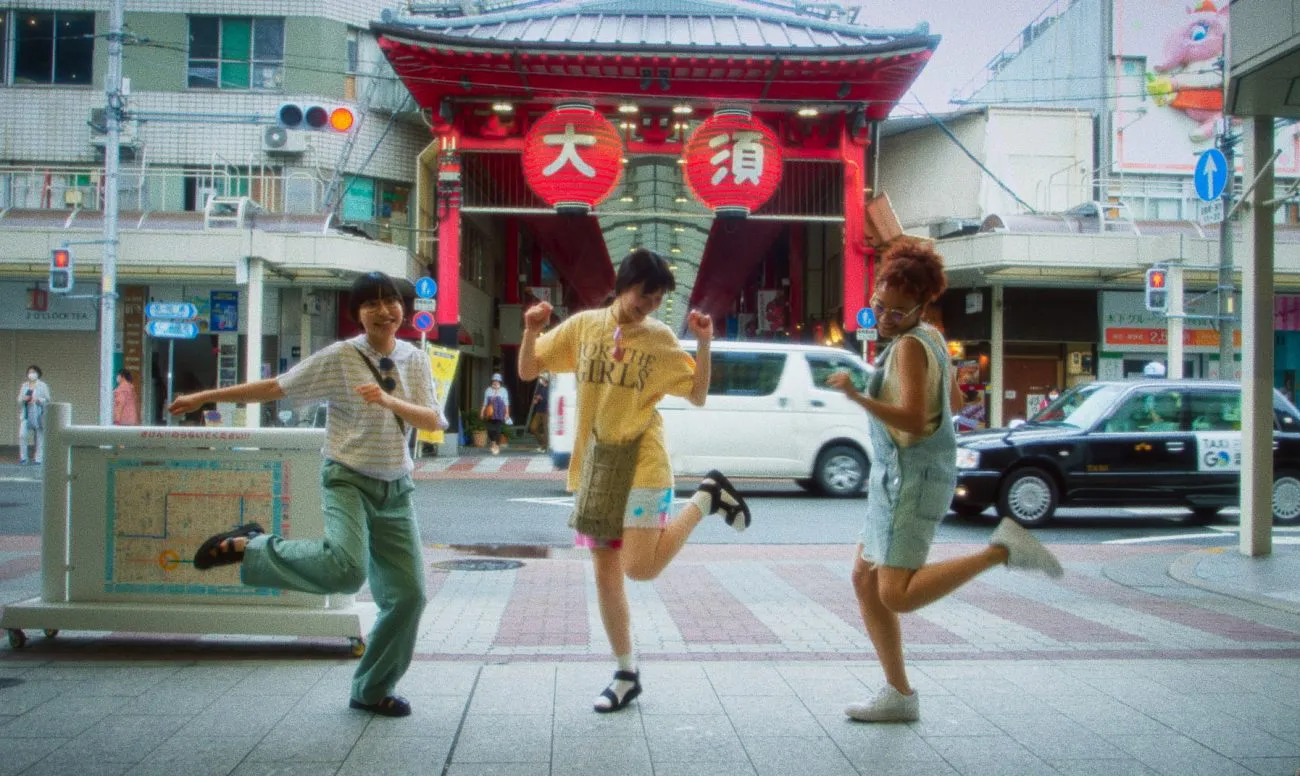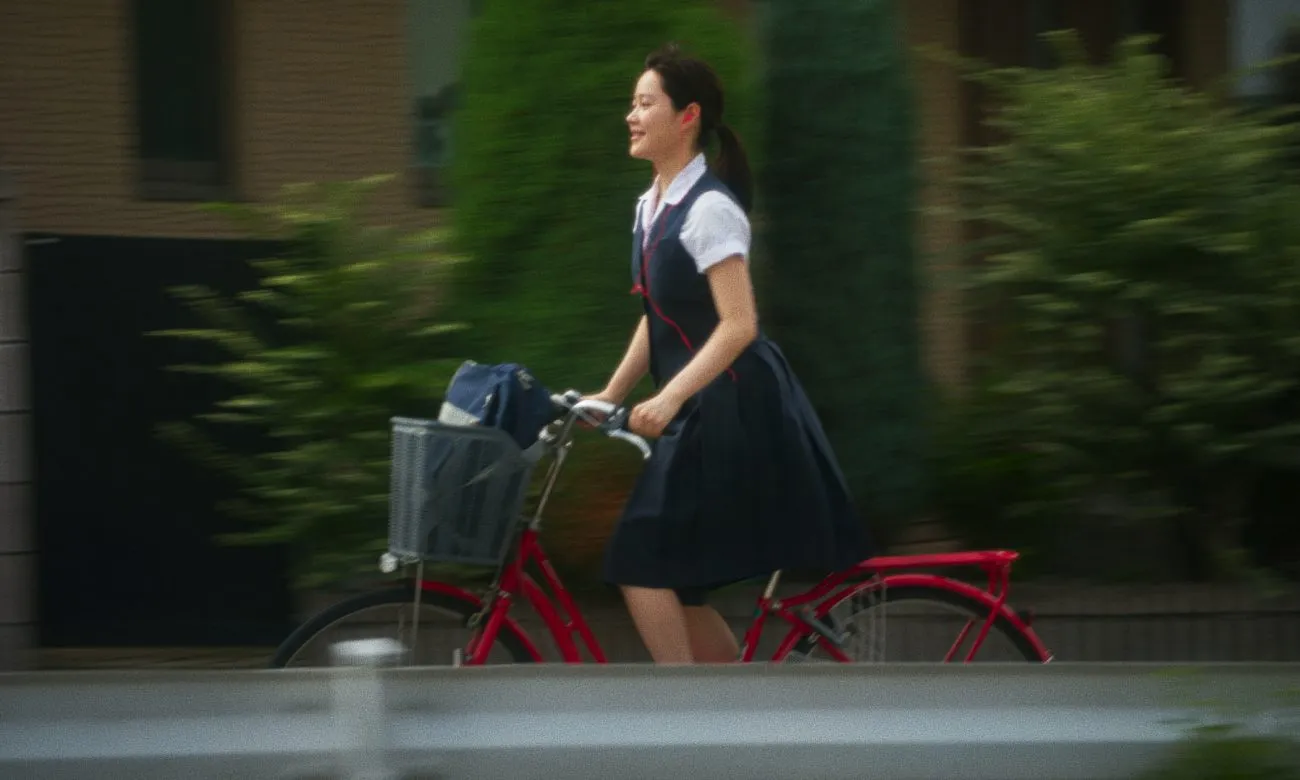In “Plastic,” directed by Daisuke Miyazaki, youth, love, and the unrelenting passage of time are explored against the backdrop of Nagoya, Japan. The film follows Jun (Takuma Fujie) and Ibuki (An Ogawa), two teens who meet by chance because they love the fictional glam-rock band Exne Kedy. Their first encounter—Ibuki pedaling home, lured to Jun’s street busking—lays the groundwork for a beautiful romance that captures adolescence’s naïve energy.
We witness their relationship evolve from charming beginnings to the complexities of adulthood, marked by aspirations, separations, and the overwhelming influence of the epidemic as the narrative progresses. Miyazaki’s film not only follows their personal journey but also resonates with a broader cultural background, reflecting a generation wrestling with aspirations and realities that frequently contradict.
Released in an era when nostalgia and authenticity are in high demand, “Plastic” speaks much about current societal trends. Using music as both a narrative vehicle and an emotional anchor, it encapsulates the common desire for connection in the chaos of modern life.
Particularly in a time marked by uncertainty and a quest for identity, the film’s exploration of young dreams and the eventual disillusionment that comes with maturation resonates powerfully. In this sense, “Plastic” is more than just a love tale; it serves as a mirror, reflecting the anxieties and aspirations of today’s youth, much like the films of the French New Wave, which so skillfully captured the zeitgeist of their time.
The intertwining of music and narrative is very notable. Just as Godard and Truffaut used sound and imagery to elicit emotional responses, Miyazaki uses the evocative power of Kensuke Ide’s soundtrack—a tribute to the 1970s rock scene—to heighten the characters’ emotional landscapes. Each song feels like its own character, guiding the audience through Jun and Ibuki’s journey in the same way jazz improvisation reflects life’s spontaneity.
Unraveling Dreams: A Character Study in “Plastic”
Jun, played by Takuma Fujie, personifies the paradigm of the ambitious artist—a figure whose dreams of musical success connect with anybody who has dared to pursue a passion. His journey begins with a strong sense of optimism as he busks around Nagoya’s streets, fuelled by a combination of youthful idealism and the lingering shadows of previous disappointments. Jun’s aspirations reflect a deeper desire for connection and affirmation, making him an approachable figure in a world where practicality frequently precedes passion.
We witness the difficult balance between love and ambition as his relationship with Ibuki progresses. Initially, their common fascination with the fictional band Exne Kedy serves as a unifying force, sparking a real and electric romance. However, as the pressures of adulthood mount—as evidenced by Jun’s effort to reconcile his music career with the obligations of everyday life—his character begins to change.
The film expertly depicts how dreams can sometimes become burdens, leading to a gradual separation from Ibuki. This progression is marked by painful moments of introspection in which Jun comes to terms with the fact that his identity is inextricably linked to his artistic aspirations and relationships. His journey is a sad reminder of the sacrifices that frequently accompany pursuing one’s dreams.
Ibuki, performed by An Ogawa, represents a more grounded view of ambition and independence. Initially shown as a supporting partner, her character’s narrative dives into the complexities of self-discovery and personal evolution. The film captures her transition from the carefree delights of youth to adulthood as she embraces her academic aspirations. This transition is brilliantly nuanced, reflecting the cultural pressures that young women frequently face—a theme that resonates strongly in contemporary movies.
Ibuki’s emotional development is very compelling. She navigates the difficulties of pursuing her education while battling her love for Jun, leading to moments of vulnerability and strength. The film does an excellent job of portraying her internal conflicts, particularly as she confronts the reality of their divergent paths. Her journey is more than just a quest for independence; it’s a profound investigation of identity and the sacrifices made to pursue personal fulfillment.
Through Jun and Ibuki, “Plastic” explores the complex dance between love and ambition, portraying their hardships with a refreshing honesty that feels timeless and relevant. This character-driven narrative not only shows individual aspirations but also reflects bigger cultural trends, particularly the anxieties of a generation trapped between dreams and reality.
In many ways, Jun and Ibuki represent the contemporary search for meaning in a world that frequently feels overwhelming, echoing the emotions seen in the works of filmmakers such as Noah Baumbach, who portrays the messiness of modern relationships.
Navigating Dreams: Thematic Depth in “Plastic”
“Plastic” captures the melancholy transition from adolescence’s careless exuberance to adulthood’s heavier obligations. The film provides a glimpse into Jun and Ibuki’s lives, highlighting their initial idealism through their mutual passion for music.
Their romance blossoms in a vivid narrative where dreams seem limitless—but as the narrative progresses, the approaching realities of life become clear. This transition is more than just a backdrop; it is a fundamental concept that resonates with a generation dealing with uncertainty and societal pressures.
The film skillfully depicts how external expectations can influence personal dreams. The tension between their respective aspirations and their relationship grows as Ibuki becomes more serious about her education, and Jun attempts to establish himself as a musician.
This dynamic reflects a larger cultural trend in which young people’s pathways are frequently controlled by societal conventions, leading to a sense of disillusionment. It reflects emotions found in current works that explore the anxieties of a generation caught between chasing dreams and the harsh realities of adult life, such as Noah Baumbach’s films.
At the center of “Plastic” is the transformational power of music, which serves as both a sanctuary and a catalyst for Jun and Ibuki’s identities. Their shared love of the fictional band Exne Kedy is more than just a bonding experience; it defines their self-perception and aspirations. The film emphasizes how music may communicate the inexpressible thoughts of youth, providing a soundtrack to their hopes and worries. Jun’s desire to succeed as a musician is intertwined with his relationship with Ibuki, demonstrating how passion can elevate and complicate one’s life.
This investigation of passion is especially relevant in today’s world, as many young adults are negotiating the complexities of self-identity against the backdrop of rapid societal change. The film’s emphasis on pursuing one’s dreams despite difficulties is a poignant reminder of the significance of remaining true to oneself. It powerfully resonates with the experiences of persons who feel caught between cultural standards and personal wants, similar to the characters in classic French New Wave films, where the quest for authenticity frequently clashes with societal conventions.
By intertwining these themes, “Plastic” recounts a personal story and reflects bigger cultural anxieties, making it a compelling and relevant piece of contemporary film. The film encourages spectators to reflect on their journeys, sparking a conversation about the difficult balance between adolescent idealism and the realities of life.
The Rhythm of Time: Narrative Structure and Pacing in “Plastic”
“Plastic” employs a non-linear narrative that perfectly captures the ebb and flow of time, mimicking the unpredictable nature of relationships and dreams. The film’s structure includes large time jumps, moving from the innocence of high school romance to the complexities of early adulthood, allowing spectators to witness the characters’ development in a poignant but fragmented manner. As we witness Jun and Ibuki navigate their evolving identities against societal pressures and personal aspirations, this strategy produces a sense of nostalgia that truly resonates.
These time jumps are successful because they elicit emotional depth. Each leap forward in time enables the audience to reflect on the characters’ development, emphasizing the bittersweet nature of their journey. For example, the transition from the euphoria of their first connection to the sober realities of adulthood emphasizes the loss of adolescent idealism.
This narrative choice reflects a broader cultural tendency in contemporary filmmaking, as filmmakers such as Greta Gerwig and Noah Baumbach explore the complexities of time and relationships, demonstrating how previous decisions impact present realities.
Another notable characteristic of “Plastic” is its pacing, which enhances its emotional impact. The film alternates between moments of reflective silence and bursts of tension, effectively reflecting the characters’ emotional problems. The early moments have a sense of spontaneity and excitement, capturing the essence of adolescent love. However, as the narrative advances and the characters confront greater pressures, the pacing changes, resulting in a more thoughtful rhythm that invites spectators to engage with their emotional struggles.
This pacing variation not only keeps the audience engaged but also emphasizes key moments of tension and conclusion. Scenes involving conflict, such as heated discussions over their futures, are deliberately designed to leave a lingering sense of uncertainty, echoing the complexities of real-life relationships. In this regard, “Plastic” resembles the works of French New Wave directors, who frequently used similar tactics to explore the complexities of love and identity.
Overall, the film’s narrative structure and pacing produce an immersive experience, inviting audiences to reflect on their journeys through the prism of Jun and Ibuki’s blossoming relationship.
The Soundtrack of Connection: The Role of Music in “Plastic”
Kensuke Ide’s music serves as a bright backdrop in “Plastic” and a critical narrative motor, propelling the tale forward. Exne Kedy, the imaginary band, encapsulates the characters’ young energy and the melancholy essence of their journey.
Ide’s compositions blend perfectly into the narrative, boosting critical moments and embellishing the emotional environment. For example, the early sequences in which Jun and Ibuki bond over their mutual love for Exne Kedy are accompanied by appealing, bouncy music that portrays a sense of joyful adventure. This musical choice effectively captures the excitement of youthful love.
The tone alters as the film continues, reflecting the characters’ experiences. The more introspective tracks punctuate their hardships, emphasizing the emotional impact of their separations and the realities of adulthood. One excellent track captures Jun’s internal conflict as he deals with the pressures of pursuing his music career, providing a touching remark on the sacrifices that come with chasing dreams. These songs’ thematic value goes beyond simply amusement; they reflect the characters’ emotional states and aspirations, making music an essential component of the tale fabric.
Music’s emotional and cultural impact in “Plastic” cannot be emphasized. It connects Jun and Ibuki, symbolizing their common dreams and the nostalgia that links them together. In a world where connections are sometimes transient, their shared love of music serves as a refuge—a means of navigating the complexities of their changing identities. The film eloquently demonstrates how music may express emotions that words cannot always convey.
The soundtrack also resonates with current cultural themes, reflecting a generation’s yearning for authenticity in the chaos of modern life. Just as jazz players improvise to communicate the inexpressible, Ide’s music creates a sound world that reflects the characters’ inner lives. This connection to music reflects larger societal themes, such as the yearning for authentic relationships in an increasingly detached world.
Through its precise blending of sound and narrative, “Plastic” emphasizes music’s transforming power, emphasizing its role as a personal and cultural artifact. The film asks spectators to reflect on their musical connections, producing a sense of nostalgia that feels especially relevant in today’s fast-paced, digitally driven society. In this way, “Plastic” is a testament to how music can bridge divides between people, providing comfort and understanding during times of change.
Framing Emotion: Visual Style and Direction in “Plastic”
Daisuke Miyazaki’s direction in “Plastic” demonstrates a strong grasp of visual narrative, which complements the film’s emotional core. His method is marked by subtlety, allowing the audience to connect emotionally with the characters’ interior difficulties.
Miyazaki employs a range of shot compositions to heighten the emotional effect of the narrative. For example, intimate close-ups of Jun and Ibuki during their moments of connection draw viewers into their world, creating a sense of intimacy and vulnerability. Wider shots of their separations, on the other hand, establish a palpable sense of physical and emotional distance, successfully depicting the schism that develops between them.
This juxtaposition of closeness and distance not only develops the characters but also reflects the more general relationship themes of connection and separation prevalent in modern relationships. Miyazaki’s use of natural light and soft focus enhances these moments, imbuing the film with a dreamlike aspect that resonates with youth nostalgia, echoing the works of French New Wave directors who used visual techniques to create emotional depth.
Miyazaki’s photography for the film employs a vibrant color palette that reflects the characters’ emotional journeys. Warm tones dominate the early chapters, symbolizing the joy and innocence of young love, while cooler tones develop as the narrative delves into themes of longing and disillusionment. This smart use of color complements the narrative and serves as a visual metaphor for the characters’ emotional states.
Furthermore, the film’s aesthetic choices are consistent with current cultural trends, in which visual narrative frequently overlaps with themes of nostalgia and identity. Miyazaki’s style is consistent with the growing popularity of independent filmmaking, which values artistic expression over traditional storytelling, similar to the stylistic advancements found in the works of filmmakers such as Greta Gerwig and Noah Baumbach.
The deliberate blend of directorial decisions and cinematic aesthetics in “Plastic” enhances the film’s emotional resonance and allows spectators to engage with its themes on a deeper level, making it a visually compelling narrative that remains long after the credits have rolled.
Resonating Echoes: Conclusion and Overall Impact of “Plastic”
“Plastic” explores youth, love, and identity complexities, expertly blending excellent character arcs and thematic complexity. The film’s portrayal of Jun and Ibuki is particularly strong, as their journeys reflect the fight between aspiration and reality. Daisuke Miyazaki’s expert direction enhances the story, as does Kensuke Ide’s evocative soundtrack, which serves as a compelling narrative engine. Visual storytelling and music integration enhance emotional and conflicting moments, creating a tapestry that resonates deeply.
However, the film is not without flaws. The pacing can sometimes be inconsistent, especially as the characters transition from young exuberance to the weight of adult responsibilities. While this serves the narrative’s goal of reflecting real-life complexities, it may leave some viewers wanting a more coherent flow.
Culturally, “Plastic” resonates strongly with today’s societal anxieties, capturing the essence of a generation navigating the tension between dreams and obligations. Its portrayal of youth and music reflects a global desire for connection and authenticity, making it more relevant in today’s fast-paced, digitally driven world.
The film’s emotional resonance lingers long after viewing, prompting thought on one’s experiences with love, ambition, and the soundtracks accompanying them. In this regard, “Plastic” stands out as an important work that entertains and encourages thinking, echoing the emotions of an independent film that aspires to explore the human condition with honesty and depth.
The Review
Plastic
"Plastic" explores youth and ambition, expertly combining narrative originality and emotional depth. Daisuke Miyazaki's direction and Kensuke Ide's evocative soundtrack create a rich tapestry that resonates with modern societal anxieties. While the pacing occasionally falters, the film's deep character journeys and thematic richness make it a notable contribution to independent filmmaking. It captures the universal fight between dreams and reality, creating an indelible impression on audiences.
PROS
- Strong character development and emotional depth.
- Innovative use of music as a narrative driver.
- Visually compelling cinematography and direction.
- Resonates with contemporary cultural themes.
- Evokes nostalgia and authenticity in storytelling.
CONS
- Pacing can be uneven at times.
- Some narrative transitions may feel abrupt.
- Certain themes could benefit from deeper exploration.
























